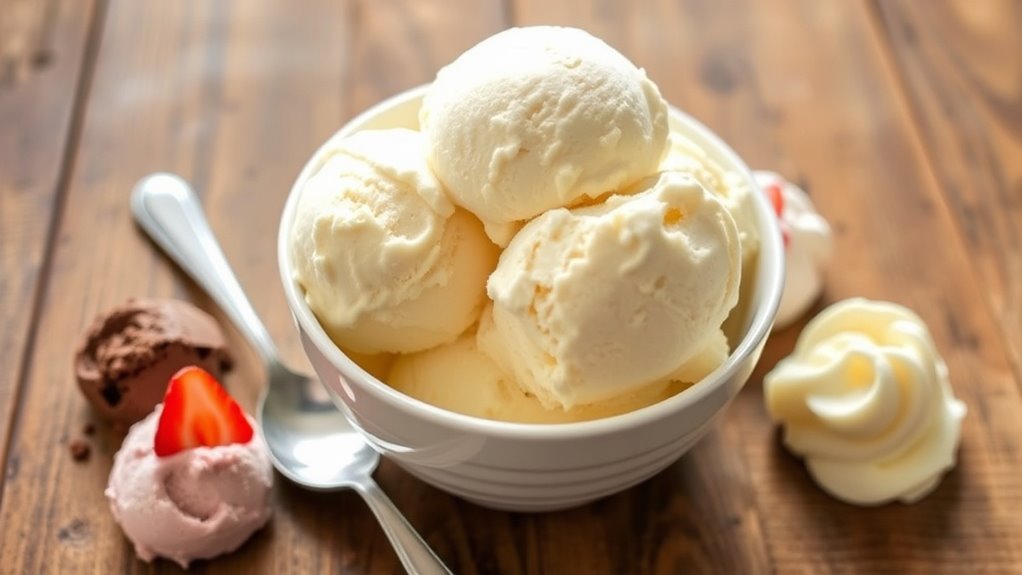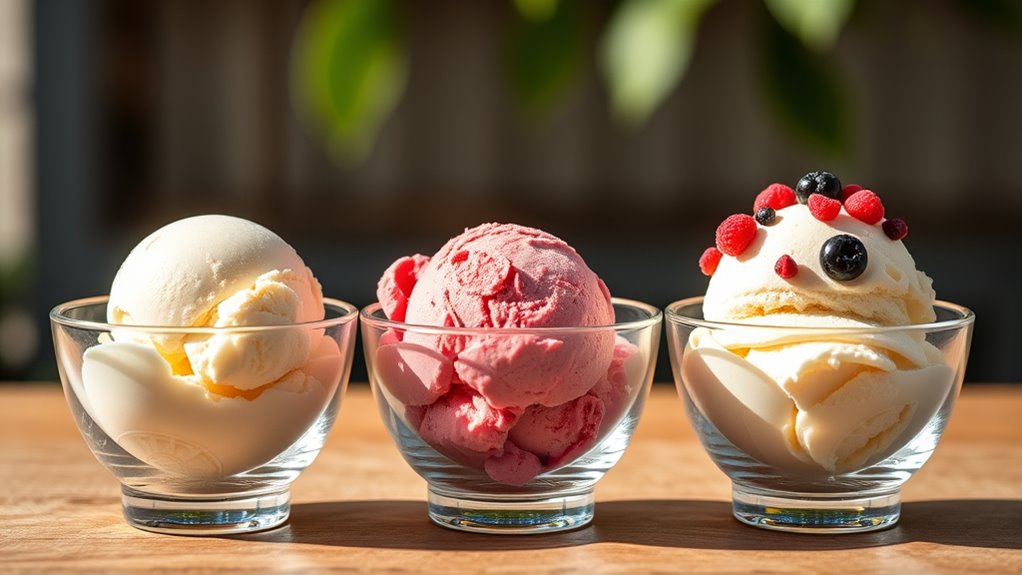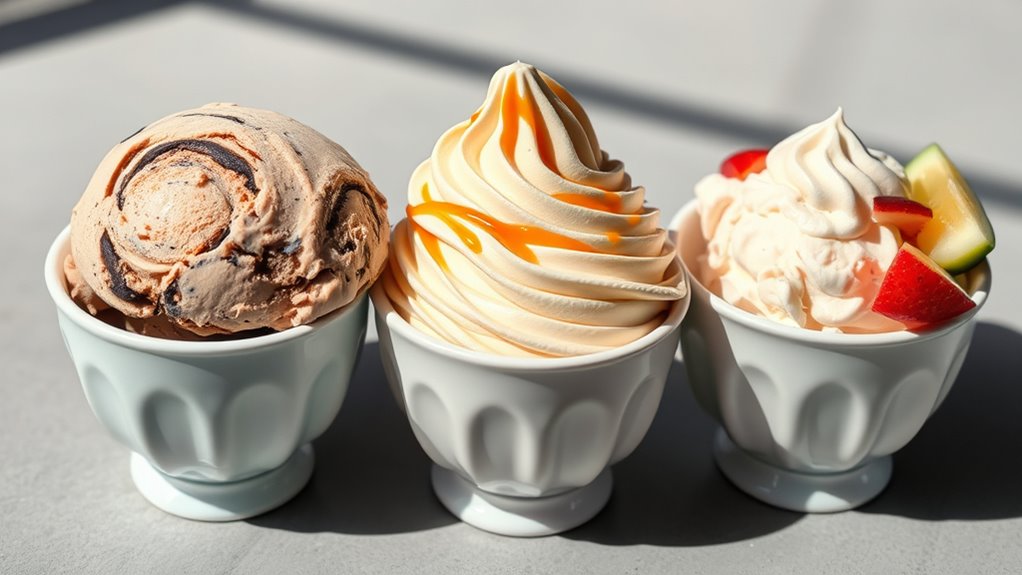When it comes to calories in ice cream, premium options have around 210 calories and 13 grams of fat per 1/2-cup serving. Regular ice cream sits at about 140 calories and 7 grams of fat, making it a more balanced treat. Low-fat varieties generally drop to around 130 calories but can still contain high levels of added sugars. If you’re curious about making healthier ice cream choices and enjoying your favorites, there’s more to discover!
Key Takeaways
- Premium ice cream contains around 210 calories and about 13 grams of fat per 1/2-cup serving.
- Regular ice cream has approximately 140 calories and 7 grams of fat per 1/2-cup serving.
- Low-fat ice cream offers about 130 calories and 2.5 grams of fat per 1/2-cup serving.
- Both premium and regular ice cream may have high added sugar content, while low-fat options often retain similar sugar levels.
- Portion control is essential for all types to manage calorie intake effectively.
Understanding Premium Ice Cream Calories

When you indulge in premium ice cream, it’s important to understand how its calorie content differs from regular varieties.
Premium vanilla ice cream typically contains around 210 calories per 1/2-cup serving, markedly higher than the 140 calories found in regular vanilla ice cream. This difference stems from the fat content, which can reach approximately 13 grams in premium options, adding to that creamy texture and rich flavor.
Premium ice creams are often made with high-quality ingredients and fewer additives, appealing to those seeking true indulgence.
Be mindful of your portion sizes; even a small serving can lead to a substantial caloric intake due to the richer formulation.
Enjoying premium ice cream certainly requires thoughtful consideration of calories and fat content!
Regular Ice Cream: A Balanced Option

For those who love ice cream but want a more balanced option, regular vanilla ice cream fits the bill perfectly. With about 140 calories and 7g of fat per 1/2-cup serving, it offers a satisfying treat without excessive guilt. While regular ice cream is high in added sugars, it also provides essential nutrients like calcium and phosphorus.
| Type of Ice Cream | Calories per Cup | Nutritional Value |
|---|---|---|
| Regular Ice Cream | 280 calories | High in sugars |
| Premium Ice Cream | 420 calories | Richer ingredients |
| Low-Fat Ice Cream | 260 calories | Lower fat content |
Enjoying regular ice cream in moderation allows you to indulge while still maintaining a balanced diet.
Low-Fat Ice Cream: Is It Worth It?

When considering low-fat ice cream, you might wonder if it really offers a healthier choice.
While it has fewer calories and fat, the sugar content and artificial ingredients can impact its nutritional value.
Let’s explore how it compares in flavor, texture, and overall health benefits. Additionally, it’s important to note that moderation is key when indulging in any ice cream, even low-fat options.
Nutritional Value Comparison
While it might seem tempting to reach for low-fat ice cream as a healthier treat, the nutritional benefits may not be as significant as you think.
Low-fat vanilla ice cream contains about 130 calories and 2.5g of fat per 1/2-cup serving, making it lower in calories compared to regular vanilla ice cream, which has 140 calories and 7g of fat.
However, it often has similar added sugars, ranging from 12 to 24g per serving, which can negate any advantages.
Plus, low-fat options may lack the creaminess of premium vanilla ice cream, which boasts around 210 calories and 13g of fat.
Always check the nutritional information; low-fat doesn’t always equal healthier ice cream when sugar intake is considered.
Flavor and Texture Differences
Many people wonder about the flavor and texture differences between low-fat ice cream and its full-fat counterparts.
While low-fat ice cream typically has around 130 calories and 2.5g of fat per serving, it often sacrifices texture and flavor.
Here’s what you might notice:
- Texture: Low-fat options can feel less creamy since fat contributes to that rich mouthfeel.
- Flavor: You may find that low-fat varieties lack the depth of flavor present in regular ice cream, as fat helps carry these taste compounds.
- Added Ingredients: Stabilizers and emulsifiers are often added to mimic creaminess, which can introduce more processed ingredients.
If you’re mindful of calories and portion control, low-fat ice cream might be a lighter choice, but it may not fully satisfy your sweet tooth.
Health Considerations and Myths
Despite the allure of low-fat ice cream as a healthier choice, it’s essential to scrutinize the real impact on your diet.
While low-fat ice cream has about 130 calories and 2.5g of fat compared to 140 calories and 7g in regular vanilla ice cream, many brands add sugars to compensate for the taste, resulting in 12–24g of added sugar per serving. Aromatic cleaning can enhance the effectiveness of traditional cleaning agents, and this principle can apply to our food choices as well, where understanding ingredient labels is crucial. Additionally, some low-fat ice creams may contain artificial ingredients that can lead to unwanted health effects.
This can diminish its supposed health benefits. Additionally, low-fat varieties often lack nutritional value, containing artificial ingredients that don’t align with a healthy diet.
You might find yourself eating larger portion sizes to satisfy your cravings, leading to calorie counts that aren’t much lower than premium options.
Always read labels to make informed choices for your healthy diet. Furthermore, many consumers are increasingly focused on sustainable practices when choosing food products, including ice cream, which may also factor into their dietary decisions.
Nutritional Comparison of Ice Cream Types

How do the calories and fat content compare across different types of ice cream? For ice cream lovers, understanding these differences is key. Here’s a quick rundown:
- Regular vanilla ice cream: About 140 calories and 7g of fat per 1/2-cup serving.
- Premium ice cream: Typically around 210 calories and 13g of fat due to richer ingredients.
- Low-fat vanilla ice cream: Offers approximately 130 calories and 2.5g of fat, making it a lower-calorie option.
Interestingly, no added sugar varieties can have about 115 calories, but fat levels may remain similar to regular options.
Interestingly, no added sugar ice creams may have fewer calories, yet their fat content can be comparable to regular varieties.
The nutritional profile varies considerably, so while healthier options exist, they’re not always superior nutritionally. Choose wisely!
Tips for Healthier Ice Cream Choices

When you’re craving ice cream, making healthier choices can help satisfy your sweet tooth without derailing your nutrition goals. Consider opting for low-calorie ice cream options, especially those with no added sugar, which can have as few as 115 calories per serving. Plant-based alternatives made from almond, coconut, or soy milk are also great for fewer calories. Practice portion control by using smaller scoops or pre-measuring servings into bowls. Always read ingredient labels to avoid added sugar and processed ingredients. Finally, try making homemade ice cream with ripe bananas and plant-based milk for a nutritious treat.
| Healthy Choices | Benefits |
|---|---|
| Low-calorie ice cream | Fewer calories |
| Plant-based alternatives | Nutritional benefits |
| Portion control | Prevents overeating |
| Homemade ice cream | No added sugar, healthier option |
Enjoying Ice Cream in Moderation

While indulging in ice cream can be a delightful treat, enjoying it in moderation is key to maintaining a balanced diet.
Many ice creams, especially premium varieties, are high in calories and sugar, making it essential to manage your intake.
Here are some tips to help you savor your favorite dessert without overdoing it:
- Set a weekly ice cream limit to control portion sizes.
- Pre-measure your serving in a bowl to promote mindful eating.
- Be cautious with toppings and skip the cone to lower calories.
Frequently Asked Questions
What Is the Difference Between Premium Regular and Low Fat Ice Cream?
When you’re choosing ice cream, think about texture and flavor.
Premium ice cream’s richer and creamier because it’s made with more cream and higher fat content.
Regular ice cream strikes a balance, offering a satisfying taste without being overly rich.
Low-fat ice cream aims to reduce fat but often compensates with added sugar, which can affect flavor.
Each type has its appeal, so it depends on what you’re craving!
Which Ice Cream Is Lowest in Calories?
Imagine you’re on a treasure hunt, searching for the sweetest, lowest-calorie gem. When it comes to ice cream, no added sugar varieties often reign supreme, boasting around 115 calories per 1/2-cup serving.
You’ll also find low-fat options at about 130 calories, making them decent contenders. Always check labels, though—some brands can surprise you.
What Is the Healthiest Ice Cream to Eat?
When you’re looking for the healthiest ice cream, focus on options with fewer calories and less added sugar.
You might want to try plant-based varieties or sorbets, as they often have lower fat content and are made with real ingredients.
Homemade ice cream using ripe bananas and plant-based milk can also be a nutritious choice.
Always check labels to guarantee you’re picking the best option for your health goals.
Enjoy your treat wisely!
How Many Calories Are in Low-Fat Ice Cream?
When you’re curious about the calories in low-fat ice cream, know that it typically contains around 130 calories per 1/2 cup serving.
While it’s a lighter choice, don’t forget that it can still have high sugar levels, sometimes even more than regular ice cream.
Always check the label to understand what you’re getting, as some brands use artificial sweeteners, which can impact both taste and texture.
Moderation is essential!
Conclusion
In the grand tapestry of ice cream, each type weaves its own story of flavor and calories. Premium ice cream’s indulgence can feel like a decadent sunset, while regular ice cream strikes a balance like a calming sea. Low-fat options might seem like a gentle breeze, but are they truly satisfying? By savoring these delights in moderation, you can enjoy the sweet symphony of flavors without letting the calorie count steal the show. So go ahead, scoop wisely!










